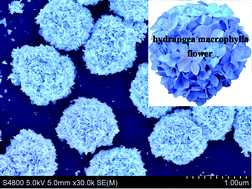Electrochemical fabrication of Hydrangea macrophylla flower-like Pt hierarchical nanostructures and their properties for methanol electrooxidation
Abstract
The electrochemical preparation of non-carbon supported catalysts is a favourable way for fuel cells to keep catalysts from agglomerating during the electrocatalytic process and provide the catalyst layer with higher mechanical stability than the established drop-coating deposition of a mixture of catalysts and carbon powder. Herein, one-step current-directed approach is proposed to fabricate 3-dimensional (3D) Pt hierarchical nanostructures (3DPHNs) without any capping agents. The resulting 3DPHNs were composed of Hydrangea macrophylla flower-like Pt microspheres, and each microsphere consisted of several nano-petals. The size, the number density and the exposed facets of Pt microspheres in 3DPHNs can be adjusted by changing the current density of Pt deposition. High-resolution transmission electron microscopy (HRTEM) revealed that Pt nano-petals obtained at deposition current densities higher or lower than 3.5 mA cm−2 contained Pt{200} and Pt{111} facets. However, Pt nano-petals obtained at 3.5 mA cm−2 were single crystals with {111} orientation that showed better specific catalytic activity and stability to methanol electrooxidation compared to commercial Pt/C catalyst due to its resistance to catalyst agglomeration and the exposure of specific facets and the specific nanostructure.


 Please wait while we load your content...
Please wait while we load your content...